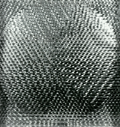
Title: Sliver Dynamo (kinetic image) (1965)
Media: Sheet of corrugated glass in front of a rotating aluminum relief disk
Size: 57x57
Location: Stadtisches Kunstmuseum Bonn
``An unexpected
way to reveal aesthetic movement arose when I trod by chance on a thin
piece of metal foil lying on sisal ma. When I picked up the foil the light
was able to vibrate. Since the matting was mechanically produced, the
impression of course remained mechanical and decorative. My metal reliefs,
which I prefer to call light reliefs, and which are formed only by finger
pressure, need light not colors in order to come to life.
Inspired by Tinguely, in 1959 he positioned
the aluminum discs so that they were rotated by an electric motor behind
a sheet of corrugated glass. The Sliver Dynamo of 1965 belongs to this
group of `Rotors`, which are also called light machines, light dynamos
and rotor-reliefs. In addition to the actual kinetic effects, the transparency
of the prefabricated corrugated glass plays a decisive part in these works,
which are set in boxes. The transparency increases the optical oscillations,
and allows them to work both spatially and immaterially at one and the
same time.
Related
sources
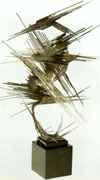
Artist:
Norber Kricke (1922-1984)
Title: Spatial Sculpture (1961)
Media: Welded steel wire
Size: Height 28 inches.
The artist makes movements, slight or considerable, with the wire, which he bends, to and fro, not infrequently with eyes closed, without optical control of paying with the wire, but with a sure sense of when it is at an end. But there is no movement without space; every movement is definition, experience of space. And the experience of space is just as defined s the self-experience of the human being expressing and unfolding himself or herself in movement. Krick's action quite unambiguously reflects this elementary state of things. It is not a question of producing an art-object but only of making visible, making tangible space as the location of the self-unfolding of human energies. Moreover the wire does not circumscribe space as fixed form, as something which arises through delimitation; the line of movement visualizes the unfolding of energies in space.
Related
sources
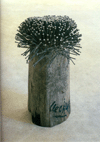
Artist:Gunther
Uecker (1930- )
Title: Rottweil saw-buck (1983)
Media: Wood, nails and paint
Size: 80x50 inches
The nail, though used in many trivial applications and also by other artists, is the call-sing of Gaunter Decker. To date he has used more then 100 tons of nails for his structural fields and to nail over everyday objects; more than any craftsman uses in a lifetime. He has not only used conventional types of nails, but has designed nails in proportions appropriate to his artistic intentions: short, stout nails with broad heavy heads. These heads are shaped lie a circle buckled on two sides, a directive shape which as a structural element of a field within the rows introduces and element of chance in addition to the local value and angle of inclination on which Uecker has spontaneously decided. The result if hardly detectable errors of the structural principle, which lead more in the regular than in the irregular fields to a form of sensitization characteristic of Uecker.
Related Sources
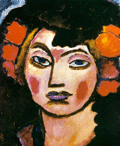
Artist:Alexej
Jawlensky (1864-1941)
Title: Spanish Girl(1912)
Media: Oil on millboard
Size: 70x51
Location: Private collection Ravensburg
His
most characteristic feature is his color, whose fluidity, flourishing
and bold modulation, and spontaneous expressive power, offers something
very refreshing. Its soft and astonishing beauty is perhaps a uniquely
Russian quality.
His heads and half-figures reveal a spiritual
quality in instantaneous creation, in a movement, turn, or glance, registered
with the least and yet most striking means. Here there is a constant tendency
to pronounced simplification and exaggeration. For this painter, art itself
has the grace and attraction of a gesture, the spiritual is expressed
directly, and every where there is evidence of the creative aspect of
an impulsive nature which derives all its best qualities from an instantaneous
inspiration which prompts it to create with a happy ease.
Related
sources
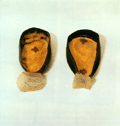
Title: Crania (1973)
Media: Two brimless trilbies made of felt filled with fat, painted with 3 brown crosses. Two small ink drawings on parchment
Size: c. 60x40x21
Location: Stadtisches Kunstmuseum Bonn
In
this work fat, felt and brown paint are used to produce a dual object:
a duplication of plastic energy which Beuys often resorts to. Here we
have a reciprocal charge and storage of sculptural force. The brown-painted
cross as a sing of the union of two (or four) different directions is
to be understood both in a vital and in a spiritual sense-it is a sing
of integration, in the way in which it is presented too: here it marks
two poles, and over there the centre. They are (in the drawings) recognizable
analogously to the `` crania``, as nutshells, with wavy surfaces where
`` J. is swimming``: here we have a self identification of the artist
with his thought movement-sculpture-thesis, and at the same time the author's
regeneration in a pulsating process which he himself initiates, and therefore
a basic topic of creativity.
`Beuy`s uniquely inclusive and progressive
conception, the central Idea of the ``extended notion of art``, has biographical
roots in his childhood and war experiences, natural roots in biological
botanical, zoological, medical and technical studies, and theosophical
roots in his interest in Rudolf Steiner. Yet these are only a few elements
of an extraordinarily rich creative base.
Fat (heat, energy, transience) and felt
(artificial-natural skin, protection, heat-insulation and heat-storage)
are frequently recurrent elements but only two of countless such components
of a wide-ranging system of analogies which in principle excludes no material
or product form its range of reference and utility. Beuys is constantly
adopting new associative possibilities, in which language (trial and lyrical),
noise, sound, music, his personal clothing and attributes participate.
Thought is (indeed) sculpture. ``
Related
sources